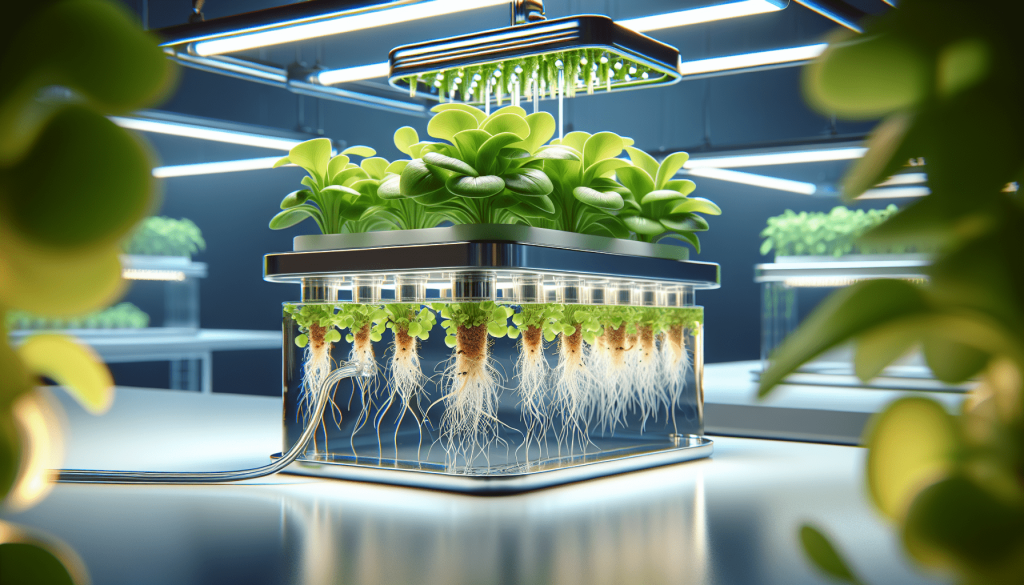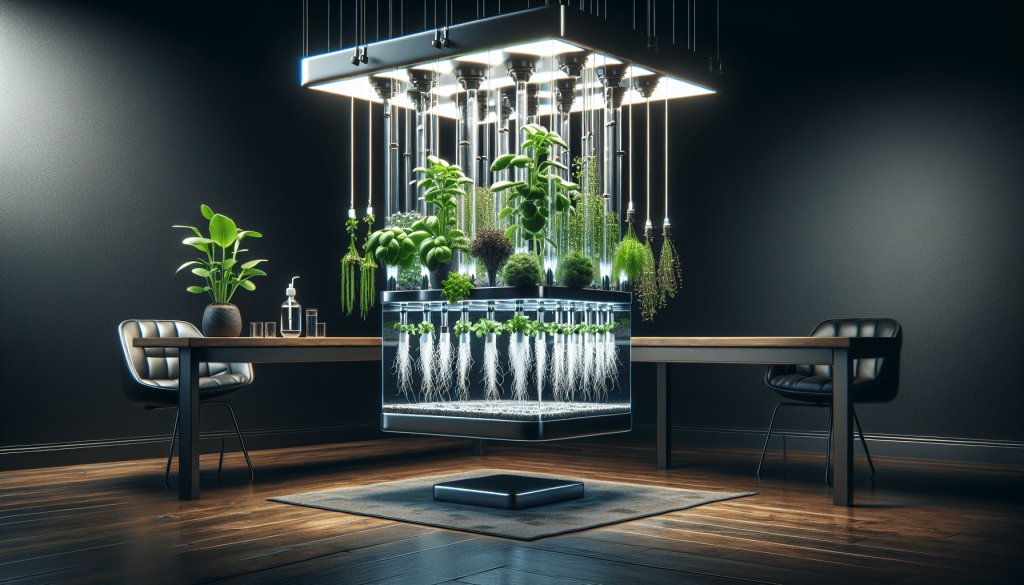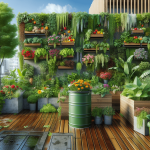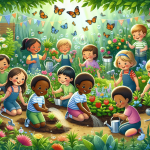This post may contain affiliate links. As an Amazon Associate, we may earn commissions from qualifying purchases.
Welcome to the captivating world of hydroponic gardening! In this article, you’ll explore the fascinating principles that make this soil-less method of growing plants so efficient and rewarding. You’ll discover the remarkable benefits, from faster growth rates to more bountiful harvests, all while conserving water and space. By following easy-to-understand steps, you’ll learn how to set up your own basic hydroponic system at home, making it possible to cultivate fresh, nutrient-rich plants regardless of your outdoor gardening space. Get ready to dive into an innovative way to make your gardening dreams a reality! Have you ever considered growing your vegetables and herbs indoors without soil? Hydroponic gardening might be the perfect solution for you! This innovative method allows plants to grow in nutrient-rich water, offering numerous benefits over traditional soil gardening. In this article, we’ll delve into the principles and benefits of hydroponic gardening and provide you with a step-by-step guide on how to set up a basic hydroponic system at home.
What Is Hydroponic Gardening?
Hydroponic gardening is a method of growing plants without soil by using a nutrient-rich water solution. This technique allows for the cultivation of plants in controlled environments, such as greenhouses or indoor gardens. The roots of the plants are suspended in the water solution, where they can directly absorb the necessary nutrients, oxygen, and water.
Principle of Hydroponic Systems
The primary principle behind hydroponic systems is to provide plants with all the essentials they need to grow, minus the soil. By delivering nutrients directly to the plant’s roots in a water-based solution, hydroponics ensures efficient and effective nutrient uptake. The following are key principles of hydroponic gardening:
- Nutrient-Rich Solution: A properly balanced mix of water and nutrients ensures plant growth.
- Oxygenation: Adequate oxygen supply to the plant roots is crucial.
- Support Medium: While soil is not used, inert mediums like coco coir, perlite, or Rockwool provide stability for plants.
- Controlled Environment: Indoor hydroponic systems allow for precise control over light, temperature, humidity, and pH levels.
Benefits of Hydroponic Gardening
Growing plants hydroponically comes with several advantages, especially for those looking to maximize efficiency and minimize space. Let’s explore some of these key benefits.
Faster Plant Growth
Hydroponic systems can significantly speed up plant growth. Without the need to search for nutrients and water in soil, plants can focus on growing and producing fruits or flowers. This direct nutrient delivery can result in faster and more abundant harvests.
Efficient Use of Space
Hydroponics allows for vertical growing, which means you can utilize space more efficiently. This makes it ideal for urban gardeners with limited outdoor space. Imagine having a flourishing garden stacked vertically in your apartment!
Reduced Water Usage
You might think growing plants in water would use more water, but hydroponic systems actually use considerably less. The closed-loop systems recycle water, reducing overall consumption. This can be a game-changer in areas with limited water availability.
Fewer Pests and Diseases
Soil is a common medium for pests and diseases that can harm your plants. Without soil, the likelihood of dealing with these issues is drastically reduced. This results in healthier plants and reduces the need for chemical pesticides.
Year-Round Gardening
With a controlled hydroponic system, you can grow plants year-round, regardless of the season. This continuous growing cycle can ensure a constant supply of fresh produce, even in the dead of winter.
Better Quality Produce
Hydroponically grown plants often have higher nutrient content and better taste. Since you control the nutrients and growing conditions, you can ensure your plants get exactly what they need to thrive.
Environmental Benefits
By using less water and fewer pesticides, hydroponic gardening has a smaller environmental footprint. Additionally, reduced transportation needs for locally grown produce can lower carbon emissions.
| Benefit | Impact |
|---|---|
| Faster Plant Growth | Quicker harvest cycles and increased production |
| Efficient Use of Space | Ideal for urban environments and small spaces |
| Reduced Water Usage | Water conservation through recycling |
| Fewer Pests and Diseases | Healthier plants with decreased need for chemicals |
| Year-Round Gardening | Continuous supply of fresh produce regardless of the season |
| Better Quality Produce | Higher nutrient content and improved taste |
| Environmental Benefits | Lower environmental impact through water savings and reduced pesticide use |

Setting Up a Basic Hydroponic System at Home
Ready to dive into hydroponic gardening? Let’s explore how you can set up your own basic system at home. We’ll break it down step by step, ensuring you have a solid understanding of each component and process.
Choosing the Right System
There are several types of hydroponic systems to choose from. For beginners, simpler systems like the Wick System or the Kratky Method are a great starting point. As you become more experienced, you can explore more complex setups like the Deep Water Culture (DWC) or Nutrient Film Technique (NFT).
- Wick System: This passive system uses a wick to draw nutrient solution to the plant roots. Simple and low-maintenance.
- Kratky Method: Another passive setup, this method involves suspending plants over a nutrient solution with no need for pumps or electricity.
- Deep Water Culture (DWC): Plants are suspended in a nutrient solution with roots submerged and oxygenated via an air pump.
- Nutrient Film Technique (NFT): A thin film of nutrient solution flows over the roots, which are suspended in a trough or tube.
| System Type | Description |
|---|---|
| Wick System | Uses a wick to draw nutrient solution to plant roots; simple and low-maintenance |
| Kratky Method | Plants are suspended over a nutrient solution; no pumps or electricity required |
| Deep Water Culture (DWC) | Roots submerged in nutrient solution with oxygen supplied by an air pump |
| Nutrient Film Technique | Thin film of nutrient solution flows over plant roots in a trough or tube |
Essential Components
Regardless of the system you choose, some basic components are essential for setting up any hydroponic garden:
- Container or Reservoir: Holds the nutrient solution.
- Grow Tray: Where plants sit; it may be integrated with the root immersion in the solution.
- Nutrient Solution: A mix of water and plant-essential nutrients.
- Growing Medium: Inert materials like Rockwool, clay pellets, vermiculite, or coco coir to support plants.
- Air Pump and Air Stone (for DWC): Ensures oxygenation of the nutrient solution.
- Light Source: LED grow lights or natural sunlight to provide energy for photosynthesis.
- pH Meter or pH Test Kit: To monitor and adjust the pH level of the nutrient solution.
- Nutrients: Specifically formulated hydroponic nutrients, usually in liquid or dry form.
Step-by-Step Setup Guide
Follow these steps to set up a basic hydroponic system at home:
- Select Your Space: Choose a location with adequate light and stable temperature. If using natural light, a south-facing window is ideal. Otherwise, consider using LED grow lights.
- Prepare the Container: Clean your container or reservoir thoroughly. This will hold your nutrient solution.
- Set Up the Grow Tray: Position the grow tray over the container and ensure it’s stable. For Wick or Kratky methods, ensure plants are suspended at the correct height.
- Add the Growing Medium: Fill net pots or cups with your chosen growing medium. Rinse the medium first to remove any residues.
- Plant Seedlings or Seeds: Place seedlings or germinated seeds in the growing medium. If using seeds, ensure they are moist but not waterlogged.
- Mix the Nutrient Solution: Follow the instructions on your hydroponic nutrients to prepare the solution. Use your pH meter or test kit to ensure the pH is between 5.5 and 6.5.
- Fill the Reservoir: Pour the nutrient solution into your container or reservoir.
- Set Up Oxygenation (for DWC): If using DWC, connect your air pump to the air stone and place it in the nutrient solution to oxygenate the water.
- Install Lighting: If natural light is insufficient, set up your LED grow lights to provide adequate coverage to all plants.
- Monitor and Maintain: Regularly check the water level, nutrient concentration, and pH. Top off with water as needed and monitor plant growth closely.
Importance of Monitoring and Maintenance
Regular monitoring and maintenance are crucial to the success of your hydroponic system. Here are some key aspects to focus on:
- Nutrient Solution: Check the concentration levels and replenish nutrients periodically. Change the solution every two weeks to prevent buildup.
- pH Levels: Maintain the pH between 5.5 and 6.5 for optimal nutrient absorption.
- Water Levels: Keep the water level consistent, topping off as necessary to ensure roots remain submerged.
- Light and Temperature: Ensure adequate lighting and maintain a stable temperature, ideally between 65°F and 75°F (18°C to 24°C).
- Cleanliness: Regularly clean your system to prevent algae growth and other contaminants.
Troubleshooting Common Hydroponic Issues
Even with meticulous care, issues can arise in hydroponic systems. Being prepared to troubleshoot common problems can save your garden and maintain healthy plant growth.
Nutrient Deficiency
If your plants show signs of nutrient deficiencies (such as yellowing leaves or stunted growth), it could be due to imbalanced or insufficient nutrients. Check the nutrient solution and adjust concentrations as needed.
pH Imbalance
Incorrect pH levels can hinder nutrient uptake. Regularly test and adjust the pH to avoid deficiencies or toxicities.
Root Rot
Over-watering or poor oxygenation can cause root rot. Ensure your system provides adequate oxygen to the roots and isn’t over-flooded.
Pests
Although less common, pests can still be an issue. Inspect your plants regularly for signs of pests and treat them using organic or hydroponic-safe pesticides.
Algae Growth
Algae can compete with your plants for nutrients. Maintain a clean system, cover reservoirs to block light, and clean algae promptly.

Tips for Successful Hydroponic Gardening
To ensure the success of your hydroponic garden, consider these additional tips:
- Start Simple: Begin with easy-to-grow plants like lettuce, herbs, or spinach to build confidence and gain experience.
- Ensure Good Air Circulation: Good air flow reduces the risk of mold and helps with CO2 circulation, crucial for photosynthesis.
- Use Quality Nutrients: Invest in high-quality hydroponic nutrients formulated for the specific plants you’re growing.
- Gradual Adjustments: Make small adjustments to nutrient and pH levels to avoid stressing your plants.
- Educate Yourself: Continue learning about hydroponics through books, online forums, and communities to stay updated with best practices.
Hydroponic gardening offers an efficient and sustainable way to grow plants indoors or in limited space. By understanding the principles and benefits, and following the steps outlined, you can create your own hydroponic garden at home. Happy gardening!








